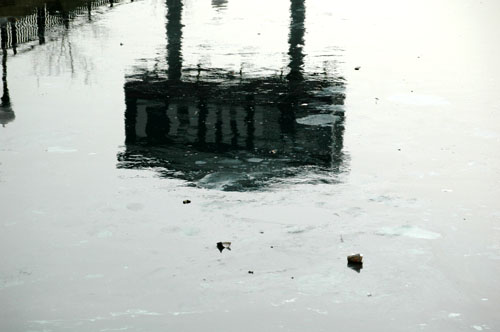
If you’re interested in getting a sense of how bad the water quality in the Gowanus Canal is, then you need to check out a recent article in Scienceline, which is published by NYU. (We found it, actually, thanks to a post in Green Brooklyn.) It provides a nice history of the Gowanus, pollution, the current state of things and its future. While things are clearly much better, it still has a way to go. Students, for instance, found gonorrhea in a drop of water that was tested and a New York City College of Technology professor is said to be “particularly interested in fluorescent white gauze that lies near the canal’s bottom, and thinks that the substance is a colonizing life form that adheres to the contaminated sediments.” Also, the oysters being cultivated in the canal are “full of lead” and core samples from the muck at the bottom of the canal have a smell of oil “so thick it would cross your eyes.” As for the future cleanup:
Plans are slowly emerging to ease the waterway’s most intractable problems. Starting next year, New York City plans to give the canal a bigger flush. This will increase water flow and remove the mounds of smelly waste. The upgrade will require shutting down the pump for the winters of 2008 and 2009 and will cost $70 million over four years — work funded through the water bills of city residents.
“When we get done, I think the Gowanus will be in pretty good shape, then all we got to do is dredge it,” said Doug Greely, the deputy commissioner for waste water treatment at New York City’s Department of Environmental Protection.
The second major phase will probably take much longer. The Army Corps of Engineers has not finalized a dredging plan or secured funds. The Corps’ Richard Dabal thinks that other options, such as entombing the sediments with a clay substance, might be a quicker way to clean the canal. Another possible solution is a combination of dredging and cleaning technology that uses high heat or additives.
Of course, there are always the swans and other wildlife on the canal. The gonorrhea, by the way, is an improvement over cholera and things that were found there in the past.

2 responses so far ↓
1 Anonymous // Oct 3, 2007 at 6:21 am
So THAT’S the real reason for the City raising the water bills! Why can’t the wealthy developers – who seem determined to build in a flood zone – foot the bill for this?
2 Anonymous // Nov 13, 2007 at 9:03 pm
I have photos of horseshoe crabs mating in the canal at 4th and bond from my painting studio!! I believe their eggs stay where they are laid until the next season. Talk about socially comunicable diseases in NYC. enough said.